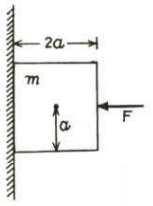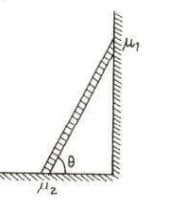MEDIUM
11th ICSE
IMPORTANT
Earn 100
The two surfaces in contact having maximum coefficient of static friction are:
(a)wood on wood
(b)steel on steel
(c)rubber on dry concrete
(d)rubber on wet concrete.
50% studentsanswered this correctly

Important Questions on Friction
EASY
11th ICSE
IMPORTANT
EASY
11th ICSE
IMPORTANT
EASY
11th ICSE
IMPORTANT
EASY
11th ICSE
IMPORTANT
A cubical block of mass is held stationary against a rough wall by applying a horizontal force , as shown. Which of the following statements is incorrect?

MEDIUM
11th ICSE
IMPORTANT
MEDIUM
11th ICSE
IMPORTANT
In the figure, a ladder of mass is shown leaning against a wall. It is in static equilibrium making an angle with the horizontal floor. The coefficient of friction between the wall and the ladder is and that between the floor and the ladder is . The normal reaction of the wall on the ladder is and that of the floor is . If the ladder is about to slip, then:

HARD
11th ICSE
IMPORTANT
MEDIUM
11th ICSE
IMPORTANT
